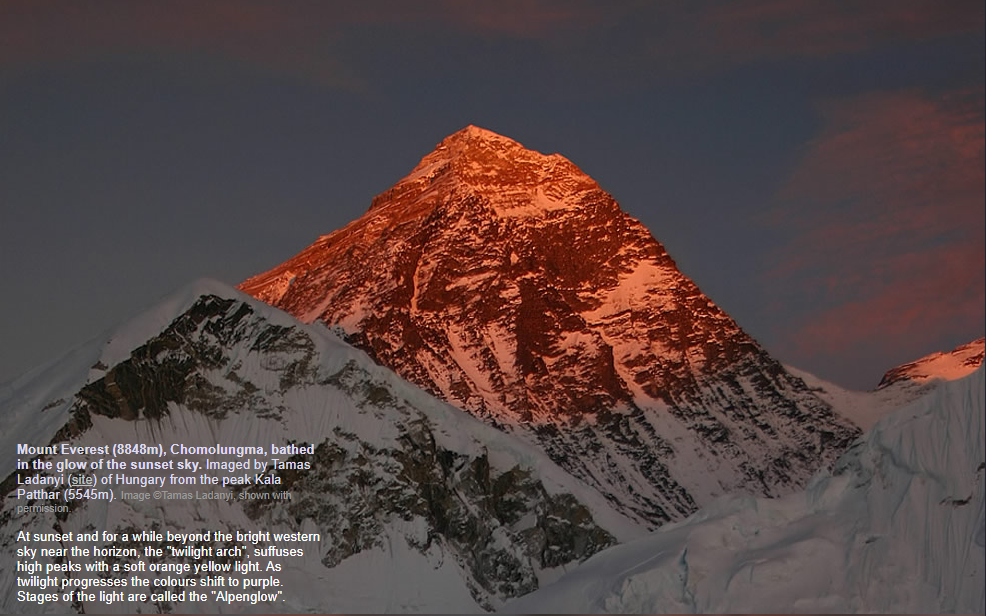Everest Alpenglow
Exploring the Phenomenon of Everest Alpenglow
When the sun sets and casts its warm rays on the horizon, a breathtaking natural phenomenon known as the "Everest Alpenglow" occurs. This captivating display of light bathes the majestic peaks of Mount Everest (also known as Chomolungma) in a soft orange-yellow glow, creating a magical spectacle that captivates both mountaineers and nature enthusiasts alike.
The Everest Alpenglow is most prominent during twilight, when the sun is below the horizon but still illuminating the sky. As the day transitions into night, a phenomenon called the "twilight arch" forms near the western horizon, casting a warm, radiant light upon the towering peaks. The alpenglow begins with a gentle hue of orange-yellow and gradually transitions to shades of purple as twilight progresses.
To witness the Everest Alpenglow in all its glory, one must venture to the peak of Kala Patthar, situated at an elevation of 5545 meters. From this vantage point, photographers and observers can capture the awe-inspiring beauty of Mount Everest bathed in this ethereal light. The photograph taken by Tamas Ladanyi from Hungary perfectly encapsulates the mesmerizing allure of the Everest Alpenglow.
The phenomenon of alpenglow occurs due to a combination of factors. As sunlight passes through Earth's atmosphere, it undergoes scattering, causing shorter wavelengths (such as blue and green) to scatter more than longer wavelengths (such as red and orange). During twilight, when the sun is low on the horizon, sunlight must traverse a greater distance through Earth's atmosphere, leading to increased scattering of shorter wavelengths. This scattering effect is responsible for the warm, vibrant colors observed during the Everest Alpenglow.
The unique geographical features surrounding Mount Everest contribute to the intensity and beauty of the alpenglow phenomenon. The towering height of the mountain allows it to catch the last rays of sunlight before the surrounding landscape, enhancing the contrast between the illuminated peak and the darkening sky. Additionally, the pristine snow and ice covering Everest's slopes act as reflective surfaces, further intensifying the brilliance of the alpenglow.
The Everest Alpenglow is not limited to Mount Everest alone; it can be observed on other high peaks as well. However, the grandeur of Everest, combined with its status as the world's highest mountain, makes the alpenglow on this iconic peak particularly mesmerizing. The interplay between light, atmosphere, and topography creates a visual spectacle that leaves observers in awe of nature's artistic prowess.
To fully appreciate the Everest Alpenglow, it is essential to experience it firsthand. The changing hues, from the soft glow of orange-yellow to the deep purples of twilight, create a dynamic and ever-evolving display. As the colors shift and intensify, the contours and features of Mount Everest become more pronounced, revealing its majestic nature in a new light.
In conclusion, the Everest Alpenglow is a captivating natural phenomenon that transforms Mount Everest into a radiant masterpiece during twilight. The interplay of light, atmosphere, and topography creates a mesmerizing display that showcases nature's artistic brilliance. To witness this awe-inspiring spectacle, one must venture to the summit of Kala Patthar and immerse themselves in the ethereal beauty of the Everest Alpenglow.

Mount Everest (8848m), Chomolungma, bathed in the glow of the sunset sky. Imaged by Tamas Ladanyi (site) of Hungary from the peak Kala Patthar (5545m). Image ©Tamas Ladanyi, shown with permission.
At sunset and for a while beyond the bright western sky near the horizon, the "twilight arch", suffuses high peaks with a soft orange yellow light. As twilight progresses the colours shift to purple. Stages of the light are called the "Alpenglow".
Note: this article has been automatically converted from the old site and may not appear as intended. You can find the original article here.
Reference Atmospheric Optics
If you use any of the definitions, information, or data presented on Atmospheric Optics, please copy the link or reference below to properly credit us as the reference source. Thank you!
-
<a href="https://atoptics.co.uk/blog/everest-alpenglow/">Everest Alpenglow</a>
-
"Everest Alpenglow". Atmospheric Optics. Accessed on November 26, 2024. https://atoptics.co.uk/blog/everest-alpenglow/.
-
"Everest Alpenglow". Atmospheric Optics, https://atoptics.co.uk/blog/everest-alpenglow/. Accessed 26 November, 2024
-
Everest Alpenglow. Atmospheric Optics. Retrieved from https://atoptics.co.uk/blog/everest-alpenglow/.